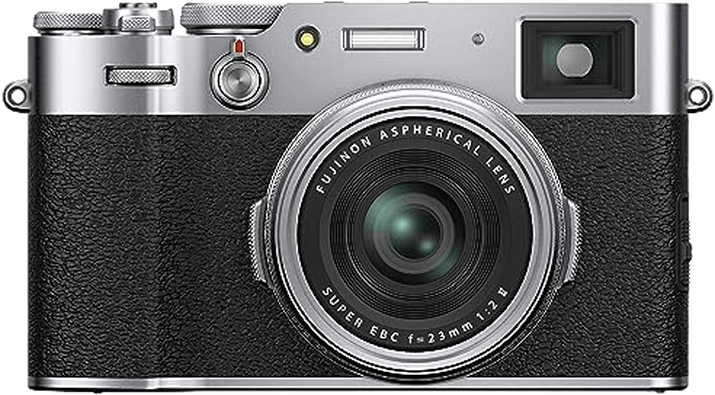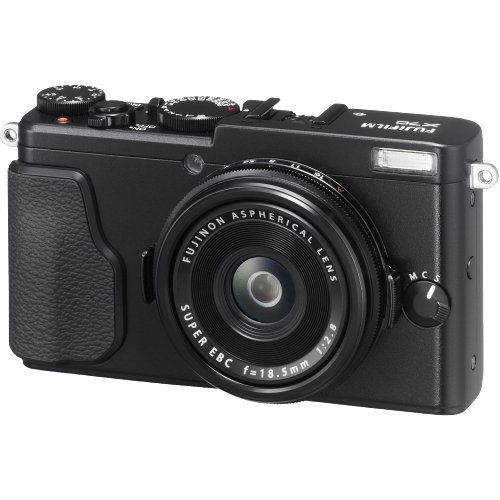Fujifilm X100V vs X70 Comparison
Fujifilm X100V

Fujifilm X70

The Fujifilm X100V outperforms the Fujifilm X70 with a score of 69/100 compared to the X70’s 53/100. Both cameras share similarities such as being lightweight and portable, with the X100V weighing 478g and the X70 weighing 340g. They also have a similar launch price, with the X100V priced at $1399 and the X70 at $799.
The X100V excels with its mirrorless camera type, making it more advanced and versatile than the compact X70. Additionally, the X100V was released in 2020, making it a more modern option compared to the X70, which was released in 2016.
However, the X70 has its advantages with its smaller size, measuring 113 x 64 x 44mm, making it more compact than the X100V, which measures 128 x 75 x 53mm. This may be a deciding factor for those who prioritize portability.
Taking all factors into account, the Fujifilm X100V is the better choice for those seeking a high-quality, versatile camera with the latest technology. The Fujifilm X70, on the other hand, is a suitable option for those who value a compact and more affordable camera.
Fujifilm X100V vs X70 Overview and Optics
The Fujifilm X100V wins the optics comparison with a score of 66/100, while the Fujifilm X70 scores 54/100. Both cameras share common specifications, such as a CMOS sensor, APS-C sensor size, and the absence of image stabilization. Additionally, both cameras have a fixed lens mount, which means the lenses cannot be changed.
The X100V outperforms the X70 in several aspects. It has a higher megapixel count of 26 compared to the X70’s 16, which allows for more detailed and higher resolution images. The X100V also has a faster shooting speed of 11 frames per second (fps) compared to the X70’s 8 fps, enabling it to capture fast-moving subjects more effectively. Furthermore, the X100V features the more advanced X-Processor 4, which results in faster processing times and better overall performance.
On the other hand, the X70 has a few advantages over the X100V. Although it has a lower megapixel count and shooting speed, the X70 is still capable of producing high-quality images. Additionally, the X70 features the EXR Processor II, which, while not as advanced as the X100V’s processor, still delivers satisfactory performance.
Based on this comparison, the X100V is the superior camera in terms of optics, offering better image quality, faster shooting speed, and a more advanced processor. While the X70 may not be as impressive, it remains a capable camera for those seeking a more affordable option. Ultimately, the choice between the two cameras depends on the individual’s preferences and needs, but the X100V stands out as the better choice for those prioritizing optics performance.
Fujifilm X100V vs X70 Video Performance
The Fujifilm X100V outperforms the Fujifilm X70 in video capabilities, as evidenced by its higher video score of 91/100 compared to the X70’s 70/100. Both cameras share some common features, such as time-lapse functionality built-in, which allows users to create stunning time-lapse videos with ease.
The X100V excels in several areas, offering superior video quality due to its maximum video resolution of 4K and dimensions of 4096 x 2160. This higher resolution results in significantly more detailed and sharper footage compared to the X70’s Full HD resolution and dimensions of 1920 x 1080. Additionally, the X100V has a higher maximum video frame rate of 120fps, allowing for smoother slow-motion effects and more dynamic video capture than the X70’s 60fps.
While the X70 does not outshine the X100V in any specific video-related aspect, it still offers decent video performance with its Full HD resolution and 60fps frame rate. For casual users or those primarily interested in photography, the X70 may still be a suitable choice.
Considering these factors, the Fujifilm X100V is the clear winner in terms of video capabilities, providing superior resolution, dimensions, and frame rate. Users looking to capture high-quality video footage will find the X100V to be a better option. However, the Fujifilm X70 is still a viable alternative for those who prioritize photography and require occasional video capture at a lower resolution.
Fujifilm X100V vs X70 Features and Benefits
The Fujifilm X100V emerges as the winner in this comparison with a feature score of 85/100, while the Fujifilm X70 trails behind with a score of 57/100. Both cameras share some common specifications, such as a 3-inch screen size, touchscreen capabilities, flip screen, no GPS, and WIFI connectivity. However, the X100V outperforms the X70 in several aspects, making it the superior choice.
The Fujifilm X100V boasts a higher screen resolution of 1,620,000 dots, compared to the X70’s 1,040,000 dots. This difference results in a sharper and clearer display on the X100V, offering a better user experience. Additionally, the X100V is equipped with Bluetooth connectivity, a feature absent in the X70. This allows for seamless pairing with compatible devices and easy data transfer, further enhancing the user experience.
In contrast, the Fujifilm X70 does not have any significant advantages over the X100V. Both cameras share similar features, but the X100V surpasses the X70 in terms of screen resolution and Bluetooth connectivity. This leads to the conclusion that the X100V is the better choice for users who prioritize a high-quality display and seamless device pairing.
To sum up, the Fujifilm X100V is the superior camera due to its higher screen resolution and Bluetooth connectivity. The Fujifilm X70, although a decent option, cannot compete with the X100V in these important aspects. Users seeking the best features should opt for the Fujifilm X100V, as it provides a better overall experience.
Fujifilm X100V vs X70 Storage and Battery
The Fujifilm X100V outperforms the Fujifilm X70 in storage and battery, scoring 37/100 compared to the X70’s 21/100. Both cameras have one memory card slot and accept SD, SDHC, and SDXC cards. However, the X100V is UHS-I compatible, providing faster data transfer and better performance.
The X100V’s battery life surpasses the X70, offering 420 shots per charge, while the X70 only provides 330 shots. Additionally, the X100V uses the NP-W126S battery type and supports USB charging, making it more convenient for users. In contrast, the X70 relies on the NP-95 battery and lacks USB charging capabilities.
Despite its lower score, the Fujifilm X70 still offers decent storage and battery options, but it cannot compete with the superior X100V. The X100V’s UHS-I compatibility, longer battery life, and USB charging make it the clear winner in this comparison.
Fujifilm X100V vs X70 – Our Verdict
Are you still undecided about which camera is right for you? Have a look at these popular comparisons that feature the Fujifilm X100V or the Fujifilm X70:

